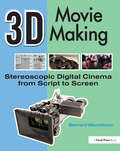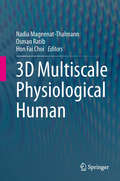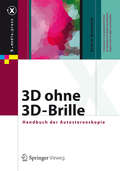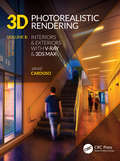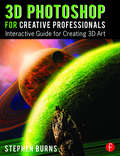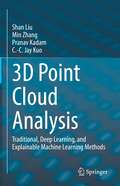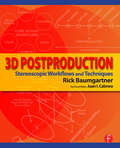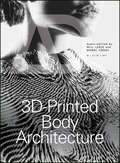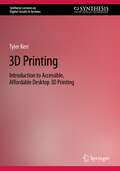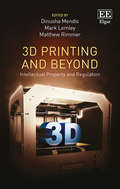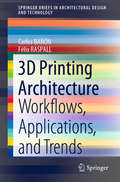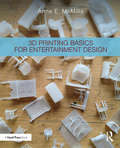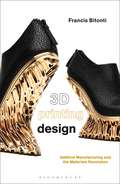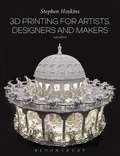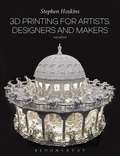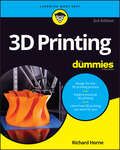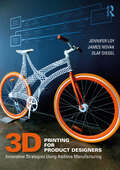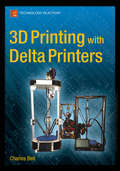- Table View
- List View
3D Movie Making: Stereoscopic Digital Cinema from Script to Screen
by Bernard MendiburuHollywood is going 3D, read this book to understand why and how, and to secure your next job on a 3D movie. Making a 3D movie is much more than shooting with a 3D camera and showing it in a 3D theater. Each and every step of the movie production cycle will be affected by 3D, just like sound and color affected the whole industry. After an introduction on how the human brain perceive depth, this book explains, in a step-by-step approach, how 3D affects screen writing, art direction, principal photography, editing, visual effects and even movies distribution. It's a must read for anyone in the profession who wants to understand the next revolution in cinema. The DVD is not included with the E-book. Please contact the publisher for access to the DVD content by emailing d.mcgonagle@elsevier.com.
3D Multiscale Physiological Human
by Nadia Magnenat-Thalmann Osman Ratib Hon Fai Choi3D Multiscale Physiological Human aims to promote scientific exchange by bringing together overviews and examples of recent scientific and technological advancements across a wide range of research disciplines. As a result, the variety in methodologies and knowledge paradigms are contrasted, revealing potential gaps and opportunities for integration. Chapters have been contributed by selected authors in the relevant domains of tissue engineering, medical image acquisition and processing, visualization, modeling, computer aided diagnosis and knowledge management. The multi-scale and multi-disciplinary research aspects of articulations in humans are highlighted, with a particular emphasis on medical diagnosis and treatment of musculoskeletal diseases and related disorders.The need for multi-scale modalities and multi-disciplinary research is an emerging paradigm in the search for a better biological and medical understanding of the human musculoskeletal system. This is particularly motivated by the increasing socio-economic burden of disability and musculoskeletal diseases, especially in the increasing population of elderly people. Human movement is generated through a complex web of interactions between embedded physiological systems on different spatiotemporal scales, ranging from the molecular to the organ level. Much research is dedicated to the understanding of each of these systems, using methods and modalities tailored for each scale. Nevertheless, combining knowledge from different perspectives opens new venues of scientific thinking and stimulates innovation. Integration of this mosaic of multifaceted data across multiple scales and modalities requires further exploration of methods in simulations and visualization to obtain a comprehensive synthesis. However, this integrative approach cannot be achieved without a broad appreciation for the multiple research disciplines involved.
3D ohne 3D-Brille: Handbuch der Autostereoskopie (X.media.press)
by Armin GrasnickSeit dem kommerziellen Erfolg des 3D-Blockbusters „Avatar“ im Jahr 2009 kommen immer mehr 3D-Filme und 3D-Fernseher auf den Markt. Mittlerweile gibt es Autostereoskopie-Verfahren, bei denen Zuschauer keine 3D-Brille mehr benötigen. In dem Band werden die derzeit verfügbaren Technologien der Autostereoskopie, ihre Funktionsweise, Anwendung und Limitierung allgemeinverständlich beschrieben. Zu jeder Technologie liefert der Band Anleitungen und Beispiele für die Erstellung von 3D-Inhalten. Alle Tools sind auf der begleitenden Internetseite verfügbar.
3D Photorealistic Rendering: Interiors & Exteriors with V-Ray and 3ds Max (3D Photorealistic Rendering)
by Jamie CardosoIncrease the photorealism of your 3d visualizations with enhanced toolsets of V-ray in 3ds Max. Full-color, step-by-step tutorials about techniques involved in creating photorealistic renders for interior/exterior scenes. Each tutorial includes a 3d project scene to guide you through, production and post-production. The production chapter shows how to create shaders, fine-tune textures and set up a day/night lighting rig. You will be rendering high-res images with render elements included for the final stage of post-production. The book also includes tips about, pre-production, camera settings, verified views, material editors, shaders, 3ds max scripts, and much more! Key Features This book deals with real world scenes and delivers up to date design direction. This book has professional supporting files ready for the reader to open and explore. This book highlights the processes of making your own content that not only gives images your personal touch, but also through the online content that will be made available for this title. Includes some coverage of VRay. Focuses in depth on separate issues surrounding interior, exterior and product design, which vary wildly.
3D Photorealistic Rendering: Interiors & Exteriors with V-Ray and 3ds Max (3D Photorealistic Rendering)
by Jamie CardosoIncrease the photorealism of your 3d visualizations with enhanced toolsets of V-ray in 3ds Max. Full-color, step-by-step tutorials about techniques involved in creating photorealistic renders for interior/exterior scenes. Each tutorial includes a 3d project scene to guide you through, production and post-production. The production chapter shows how to create shaders, fine-tune textures and set up a day/night lighting rig. You will be rendering high-res images with render elements included for the final stage of post-production. The book also includes tips about, pre-production, camera settings, verified views, material editors, shaders, 3ds max scripts, and much more!
3D Photoshop for Creative Professionals: Interactive Guide for Creating 3D Art
by Stephen BurnsPhotoshop is the cornerstone of the graphics industry and understanding its 3D capabilities is becoming a requirement for graphic designers, photographers, and creatives alike. Starting with the fundamental tools and ending with advanced resources, Adobe Community Professional Stephen Burns guides you with a clear voice and creative exercises that encourage you to work as you read. Accompanied by a free app that includes video tutorials, interactive models to compare your activity work from the book against, and on-going updates about the latest Photoshopreleases, this book will elevate your art off the page and into a new world of possibilities. (The app is available for the iPad and iPhone in the iTunes App Store, and Android users can find it through Google Play. Just search for 3D Photoshop on either of these platforms and download it to your device.)
3D Photoshop for Creative Professionals: Interactive Guide for Creating 3D Art
by Stephen BurnsPhotoshop is the cornerstone of the graphics industry and understanding its 3D capabilities is becoming a requirement for graphic designers, photographers, and creatives alike. Starting with the fundamental tools and ending with advanced resources, Adobe Community Professional Stephen Burns guides you with a clear voice and creative exercises that encourage you to work as you read. Accompanied by a free app that includes video tutorials, interactive models to compare your activity work from the book against, and on-going updates about the latest Photoshopreleases, this book will elevate your art off the page and into a new world of possibilities. (The app is available for the iPad and iPhone in the iTunes App Store, and Android users can find it through Google Play. Just search for 3D Photoshop on either of these platforms and download it to your device.)
3D Point Cloud Analysis: Traditional, Deep Learning, and Explainable Machine Learning Methods
by Shan Liu Min Zhang Pranav Kadam C.-C. Jay KuoThis book introduces the point cloud; its applications in industry, and the most frequently used datasets. It mainly focuses on three computer vision tasks -- point cloud classification, segmentation, and registration -- which are fundamental to any point cloud-based system. An overview of traditional point cloud processing methods helps readers build background knowledge quickly, while the deep learning on point clouds methods include comprehensive analysis of the breakthroughs from the past few years. Brand-new explainable machine learning methods for point cloud learning, which are lightweight and easy to train, are then thoroughly introduced. Quantitative and qualitative performance evaluations are provided. The comparison and analysis between the three types of methods are given to help readers have a deeper understanding. With the rich deep learning literature in 2D vision, a natural inclination for 3D vision researchers is to develop deep learning methods for point cloud processing. Deep learning on point clouds has gained popularity since 2017, and the number of conference papers in this area continue to increase. Unlike 2D images, point clouds do not have a specific order, which makes point cloud processing by deep learning quite challenging. In addition, due to the geometric nature of point clouds, traditional methods are still widely used in industry. Therefore, this book aims to make readers familiar with this area by providing comprehensive overview of the traditional methods and the state-of-the-art deep learning methods. A major portion of this book focuses on explainable machine learning as a different approach to deep learning. The explainable machine learning methods offer a series of advantages over traditional methods and deep learning methods. This is a main highlight and novelty of the book. By tackling three research tasks -- 3D object recognition, segmentation, and registration using our methodology -- readers will have a sense of how to solve problems in a different way and can apply the frameworks to other 3D computer vision tasks, thus give them inspiration for their own future research. Numerous experiments, analysis and comparisons on three 3D computer vision tasks (object recognition, segmentation, detection and registration) are provided so that readers can learn how to solve difficult Computer Vision problems.
3D Postproduction: Stereoscopic Workflows and Techniques
by Rick BaumgartnerMaster the complex realities of 3D postproduction workflows and solutions with this one-of-a-kind guide. Brimming with techniques that have been used on actual 3D productions and can easily be incorporated into your own workflows, Rick Baumgartner’s 3D Postproduction offers you: The best practices for 3D preproduction and production to ensure a smooth post process, saving both time and money Abundant workflow diagrams, screen grabs, and checklists to reinforce your learning with visual cues Common postproduction considerations such as dailies, assembly, cutting, and color correction, and how they differ between 3D and 2D post pipelines Examples of 3D gone bad and how those scenarios can be avoided In-depth interviews with working professionals and extensive tutorials that provide practical insight from the trenches of real-world 3D postproduction A companion website (www.focalpress.com/cw/baumgartner) featuring project files and video clips demonstrating the 3D workflows covered in the book An effective 3D postproduction workflow allows for easier and more flexible editing, greater capacity for visual effects enhancement, the ability to fix production mistakes, and much more. You can’t afford to miss out! Bring your 3D projects to the next level with 3D Postproduction: Stereoscopic Workflows and Techniques.
3D Postproduction: Stereoscopic Workflows and Techniques
by Rick BaumgartnerMaster the complex realities of 3D postproduction workflows and solutions with this one-of-a-kind guide. Brimming with techniques that have been used on actual 3D productions and can easily be incorporated into your own workflows, Rick Baumgartner’s 3D Postproduction offers you: The best practices for 3D preproduction and production to ensure a smooth post process, saving both time and money Abundant workflow diagrams, screen grabs, and checklists to reinforce your learning with visual cues Common postproduction considerations such as dailies, assembly, cutting, and color correction, and how they differ between 3D and 2D post pipelines Examples of 3D gone bad and how those scenarios can be avoided In-depth interviews with working professionals and extensive tutorials that provide practical insight from the trenches of real-world 3D postproduction A companion website (www.focalpress.com/cw/baumgartner) featuring project files and video clips demonstrating the 3D workflows covered in the book An effective 3D postproduction workflow allows for easier and more flexible editing, greater capacity for visual effects enhancement, the ability to fix production mistakes, and much more. You can’t afford to miss out! Bring your 3D projects to the next level with 3D Postproduction: Stereoscopic Workflows and Techniques.
3D-Printed Body Architecture (Architectural Design)
by Neil Leach Behnaz FarahiSome architects dream of 3D-printing houses. Some even fantasise about 3D-printing entire cities. But what is the real potential of 3D printing for architects? This issue focuses on another strand of 3D-printing practice emerging among architects operating at a much smaller scale that is potentially more significant. Several architects have been working with the fashion industry to produce some exquisitely designed 3D-printed wearables. Other architects have been 3D-printing food, jewellery and other items at the scale of the human body. But what is the significance of this work? And how do these 3D-printed body-scale items relate to the discipline of architecture? Are they merely a distraction from the real business of the architect? Or do they point towards a new form of proto-architecture – like furniture, espresso makers and pavilions before them – that tests out architectural ideas and explores tectonic properties at a smaller scale? Or does this work constitute an entirely new arena of design? In other words, is 3D printing at the human scale to be seen as a new genre of 'body architecture'? This issue contains some of the most exciting work in this field today, and seeks to chart and analyse its significance. Contributors include: Paola Antonelli/MoMA, Francis Bitonti, Niccolo Casas, Behnaz Farahi, Madeline Gannon, Eric Goldemberg/MONAD Studio, Kyle von Hasseln/3D Systems Culinary Lab, Rem D Koolhaas, Julia Kӧrner, Neil Leach, Steven Ma/Xuberance, Neri Oxman/MIT Media Lab, Ronald Rael and Virginia San Fratello, Gilles Retsin, Jessica Rosenkrantz/Nervous System, and Patrik Schumacher/Zaha Hadid Architects.
3D Printing: Introduction to Accessible, Affordable Desktop 3D Printing (Synthesis Lectures on Digital Circuits & Systems)
by Tyler KerrThis book is an introduction to the wide and varied world of 3D printing—an incredible technology used across an ever-growing list of industries. As 3D printing continues to skyrocket in popularity, it’s increasingly important to understand how these machines work and how to apply 3D printing technology to personal and professional interests. More important still, this book highlights how surprisingly easy 3D printers can be to use, even for readers who don’t consider themselves particularly tech-savvy. This book provides a comprehensive overview of 3D printing for first-time users. The text introduces some of the most popular types of 3D printing technology available, as well as some of the most exciting and compelling applications across industry today. The content dives deeply into one of the most popular and widely accessible 3D print technology on the market: fused deposition modeling (FDM) 3D printing. The reader will learn basic FDM 3D printer anatomy, software settings, as well as the tips and tricks to master your own FDM 3D printer. The book provides a firm understanding of what FDM 3D printing excels at, its current limitations, and how to troubleshoot and overcome some of the most common 3D printing problems. The book then provides some ‘STEAM-building’ cross-disciplinary challenges and applications for the reader to complete at home. This book is for novice readers who might be early in their 3D printing journey. For those looking to learn more about introductory 3D printing and curious about how to get started, this is an excellent place to start. By the end of the book, the reader should have all the understanding and tools necessary to start 3D printing with confidence.
3D Printing and Beyond: Intellectual Property and Regulation
by Dinusha Mendis Mark Lemley Matthew RimmerThis ground-breaking and timely contribution in the field of intellectual property law explores the implications of 3D printing and additive manufacturing in three core jurisdictions: the UK, USA and Australia. Providing in-depth analysis of the current state of affairs, as well as outlining future issues and developments, 3D Printing and Beyond addresses both the challenges and opportunities created by 3D printing. Combining expertise from academia and practice, the original contributions to this book consider the regulation of new, emerging and future technologies and their implications for the legal landscape. The book goes beyond 3D printing and its relationship with intellectual property to the realms of ethics, contracts, socio-legal aspects and economics. Intellectual property academics will greatly benefit from reading this book, as it not only explores the myriad ways in which 3D printing has altered the horizon of intellectual property law, but also offers ideas for areas of future research. Practitioners and policy makers will also benefit from the useful examples and cases used in this book.
3D Printing Architecture: Workflows, Applications, and Trends (SpringerBriefs in Architectural Design and Technology)
by Carlos BAÑÓN Félix RASPALLThis book investigates how architectural design advances as a result of the rapid developments in 3D Printing. As this technology become more powerful, faster and cheaper, novel workflows are becoming available and revolutionizing all stages of the design process, from early spatial concepts, to subsequent project development, advanced manufacturing processes, and integration into functional buildings. Based on a literature review and case studies of ten built projects, the book discusses the implications of the ongoing manufacturing revolution for the field of architecture.
3D Printing Basics for Entertainment Design
by Anne E. McMillsAffordable 3D printers are rapidly becoming everyday additions to the desktops and worktables of entertainment design practitioners – whether working in theatre, theme parks, television and film, museum design, window displays, animatronics, or… you name it! We are beginning to ask important questions about these emerging practices: · How can we use 3D fabrication to make the design and production process more efficient? · How can it be used to create useful and creative items? · Can it save us from digging endlessly through thrift store shelves or from yet another late-night build? · And when budgets are tight, will it save us money? This quick start guide will help you navigate the alphabet soup that is 3D printing and begin to answer these questions for yourself. It outlines the basics of the technology, and its many uses in entertainment design. With straightforward and easy-to-follow information, you will learn ways to acquire printable 3D models, basic methods of creating your own, and tips along the way to produce successful prints. Over 70 professionals contributed images, guidance, and never-before-seen case studies filled with insider secrets to this book, including tutorials by designer and pioneer, Owen M. Collins.
3D Printing Basics for Entertainment Design
by Anne E. McMillsAffordable 3D printers are rapidly becoming everyday additions to the desktops and worktables of entertainment design practitioners – whether working in theatre, theme parks, television and film, museum design, window displays, animatronics, or… you name it! We are beginning to ask important questions about these emerging practices: · How can we use 3D fabrication to make the design and production process more efficient? · How can it be used to create useful and creative items? · Can it save us from digging endlessly through thrift store shelves or from yet another late-night build? · And when budgets are tight, will it save us money? This quick start guide will help you navigate the alphabet soup that is 3D printing and begin to answer these questions for yourself. It outlines the basics of the technology, and its many uses in entertainment design. With straightforward and easy-to-follow information, you will learn ways to acquire printable 3D models, basic methods of creating your own, and tips along the way to produce successful prints. Over 70 professionals contributed images, guidance, and never-before-seen case studies filled with insider secrets to this book, including tutorials by designer and pioneer, Owen M. Collins.
3D Printing Design: Additive Manufacturing and the Materials Revolution (Required Reading Range Ser.)
by Francis BitontiTo work with the materials of tomorrow, design students across visual arts disciplines need to understand the cutting edge of today. Whether you're modelling in interiors, designing in fashion or constructing for interiors, in your work or as part of a final project, 3D Printing design is an encouraging guide to additive manufacturing within design disciplines. Francis Bitonti gives an insider's view from his design studio on how 3D printing is already shaking up the industry, and where it's likely to go next. Complete with interviews from designers, business owners and 3D-print experts throughout, Bitonti considers whether 3D body scans mean couture for all, how rapid prototyping can change your design method and if 3D printing materials can enhance medical design, amongst other areas of this emerging method of manufacture. This is inspirational reading for the designers of tomorrow.
3D Printing Design: Additive Manufacturing and the Materials Revolution
by Francis BitontiTo work with the materials of tomorrow, design students across visual arts disciplines need to understand the cutting edge of today. Whether you're modelling in interiors, designing in fashion or constructing for interiors, in your work or as part of a final project, 3D Printing design is an encouraging guide to additive manufacturing within design disciplines. Francis Bitonti gives an insider's view from his design studio on how 3D printing is already shaking up the industry, and where it's likely to go next. Complete with interviews from designers, business owners and 3D-print experts throughout, Bitonti considers whether 3D body scans mean couture for all, how rapid prototyping can change your design method and if 3D printing materials can enhance medical design, amongst other areas of this emerging method of manufacture. This is inspirational reading for the designers of tomorrow.
3D Printing for Artists, Designers and Makers
by Stephen HoskinsFully revised and with a new chapter and international case studies, this second edition of the best-selling book traces how artists and designers continue to adapt and incorporate 3D printing technology into their work and explains how the creative industries are directly interfacing with this new technology. Covering a broad range of applied art practice – from fine art and furniture-design to film-making – Stephen Hoskins introduces some of his groundbreaking research from the Centre for Fine Print Research along with an updated history of 3D print technology, a new chapter on fashion and animation, and new case studies featuring artists working with metal, plastic, ceramic and other materials. A fascinating investigation into how the applied arts continue to adapt to new technologies and a forecast of what developments we might expect in the future, this book is essential reading for students, researchers studying contemporary art and design and professionals involved in the creative industries.
3D Printing for Artists, Designers and Makers
by Stephen HoskinsFully revised and with a new chapter and international case studies, this second edition of the best-selling book traces how artists and designers continue to adapt and incorporate 3D printing technology into their work and explains how the creative industries are directly interfacing with this new technology. Covering a broad range of applied art practice – from fine art and furniture-design to film-making – Stephen Hoskins introduces some of his groundbreaking research from the Centre for Fine Print Research along with an updated history of 3D print technology, a new chapter on fashion and animation, and new case studies featuring artists working with metal, plastic, ceramic and other materials. A fascinating investigation into how the applied arts continue to adapt to new technologies and a forecast of what developments we might expect in the future, this book is essential reading for students, researchers studying contemporary art and design and professionals involved in the creative industries.
3D Printing For Dummies
by Richard HornePrint out whatever you can dream up 3D Printing For Dummies is an easy reference for anyone new to the process of taking a digital file and turning it into an object in the real world. (Pretty amazing stuff, right?) It’s also a handy guide for more experienced users looking to learn the latest and greatest in additive manufacturing. Updated for the latest generation of machines and materials, this book walks you through creating models and printing 3D objects. You’ll get the scoop on the impact of these versatile machines in production and manufacturing, reuse and recycling, intellectual property design controls, and more. It’s an exciting time to get into 3D printing, and this friendly Dummies guide is here to help you do it. Wrap your mind around the technology of 3D printing Understand how 3D printing is transforming industries Get an intro to making your own digital models Consider the pros and cons of 3D printing for your hobby or business needs3D Printing For Dummies is a perfect resource for anyone interested in learning about and taking advantage of 3D printing technology.
3D Printing For Dummies
by Richard HornePrint out whatever you can dream up 3D Printing For Dummies is an easy reference for anyone new to the process of taking a digital file and turning it into an object in the real world. (Pretty amazing stuff, right?) It’s also a handy guide for more experienced users looking to learn the latest and greatest in additive manufacturing. Updated for the latest generation of machines and materials, this book walks you through creating models and printing 3D objects. You’ll get the scoop on the impact of these versatile machines in production and manufacturing, reuse and recycling, intellectual property design controls, and more. It’s an exciting time to get into 3D printing, and this friendly Dummies guide is here to help you do it. Wrap your mind around the technology of 3D printing Understand how 3D printing is transforming industries Get an intro to making your own digital models Consider the pros and cons of 3D printing for your hobby or business needs3D Printing For Dummies is a perfect resource for anyone interested in learning about and taking advantage of 3D printing technology.
3D Printing for Product Designers: Innovative Strategies Using Additive Manufacturing
by Jennifer Loy James Novak Olaf Diegel3D Printing for Product Designers closes the gap between the rhetoric of 3D printing in manufacturing and the reality for product designers. It provides practical strategies to support the adoption and integration of 3D printing into professional practice. 3D printing has evolved over the last decade into a practical proposition for manufacturing, opening up innovative opportunities for product designers. From its foundations in rapid prototyping, additive manufacturing has developed into a range of technologies suitable for end-use products. This book shows you how to evaluate and sensitively understand people, process, and products and demonstrates how solutions for working with additive manufacturing can be developed in context. It includes a practical, step-by-step plan for product designers and CEOs aimed at supporting the successful implementation of 3D printing by stakeholders at all levels of a manufacturing facility, tailored to their stage of technology integration and business readiness. It features a wide range of real-world examples of practice illustrated in full colour, across industries such as healthcare, construction, and film, aligning with the strategic approach outlined in the book. The book can be followed chronologically to guide you to transform your process for a company, to meet the unique needs of a specific client, or to be used as a starting point for the product design entrepreneur. Written by experienced industry professionals and academics, this is a fundamental reference for product designers, industrial designers, design engineers, CEOs, consultants, and makers.
3D Printing for Product Designers: Innovative Strategies Using Additive Manufacturing
by Jennifer Loy James Novak Olaf Diegel3D Printing for Product Designers closes the gap between the rhetoric of 3D printing in manufacturing and the reality for product designers. It provides practical strategies to support the adoption and integration of 3D printing into professional practice. 3D printing has evolved over the last decade into a practical proposition for manufacturing, opening up innovative opportunities for product designers. From its foundations in rapid prototyping, additive manufacturing has developed into a range of technologies suitable for end-use products. This book shows you how to evaluate and sensitively understand people, process, and products and demonstrates how solutions for working with additive manufacturing can be developed in context. It includes a practical, step-by-step plan for product designers and CEOs aimed at supporting the successful implementation of 3D printing by stakeholders at all levels of a manufacturing facility, tailored to their stage of technology integration and business readiness. It features a wide range of real-world examples of practice illustrated in full colour, across industries such as healthcare, construction, and film, aligning with the strategic approach outlined in the book. The book can be followed chronologically to guide you to transform your process for a company, to meet the unique needs of a specific client, or to be used as a starting point for the product design entrepreneur. Written by experienced industry professionals and academics, this is a fundamental reference for product designers, industrial designers, design engineers, CEOs, consultants, and makers.
3D Printing with Delta Printers
by Charles BellDo you find yourself wondering what the fuss is about a delta 3D printer? Perhaps you’ve decided to buy one but all of your 3D printing friends are busily perfecting their Cartesian printers. Maybe you find yourself stymied by the fact that your delta printer has very different needs for setup, configuration, calibration, and maintenance than Cartesian printers.3D Printing with Delta Printers contains detailed descriptions of the innovative delta design including unique hardware, software, and maintenance requirements. The book also covers tips for building your own delta printer as well as examples of common enhancements.This book will enable you to build, configure, and enhance your delta printer. The topics covered will reveal the often-mysterious nuances of the delta design that will enable your printer to compete with the best of what your 3D printer friends can build.
